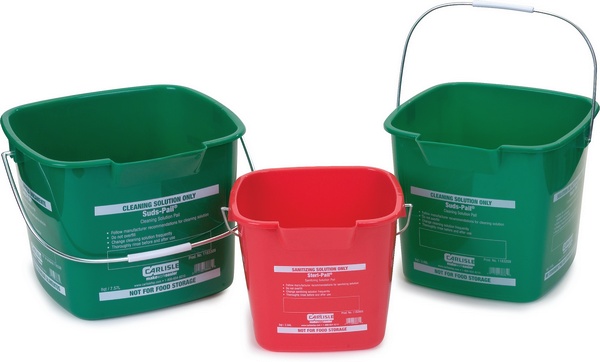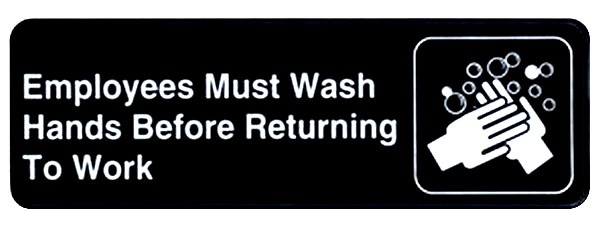Welcome back to our blog series, The Power of Clean. In this series, we are discussing the power of clean and sanitary facilities to make a positive impact in your foodservice establishment. In Part 1, we talked about the impact of clean and sanitary cookware. In Part 2, we will be talking about work and food contact surfaces and proper procedures for cleaning and sanitizing. We naturally think of items like cutting boards and cookware as food-contact surfaces, but in reality, any surface near where food is being prepared or served is potentially a food-contact surface. Therefore, our definition of a food-contact surface should not be limited to food prep areas but should extend to other areas such as the expediter station and wait staff service areas. Basically, any surface that touches food needs to be cleaned and sanitized.
What is the difference between cleaning and sanitizing? Cleaning removes soil and foodstuff from surfaces while sanitizing reduces the level of pathogens (microorganisms that can cause foodborne illness) to safe levels. Different products are required for cleaning and sanitizing. Cleaning agents or detergents must be noncorrosive and safe for use in commercial food service establishments. For cleaning food contact surfaces, we recommend a commercial all-surface cleaner that degreases the surface when applied. A mild solution of dishwashing soap and water works well for this task as well. There are several different products for sanitizing, but the most commonly used are quaternary sanitizer and chlorine bleach.
For proper cleaning and sanitizing of food-contact surfaces, you will need the following products:
- Sterile pails for holding cleaning and sanitizing solutions. Sterile pails are color-coded. You will need green for cleaning solutions and red for sanitizing solutions.
- Test Strips to test the concentration of the sanitizing solution. There are different test strips for quaternary sanitizer and bleach. You will need the correct test strips for each.
- Separate kitchen towels for cleaning and sanitizing.
- A detergent or all-surface cleaner approved for use in foodservice establishments.
- Either quaternary sanitizer or chlorine bleach.
- Clean water.
Once you have gathered your supplies, follow these steps for cleaning and sanitizing: First prepare your cleaning solution in the green pail according to the manufacturer’s recommendation. Next, prepare your sanitizing solution in the red pail according to the manufacturer’s recommendation and test the concentration with your test strips. If you are using quaternary sanitizer, verify that the concentration meets the manufacturer’s specifications. If you are using chlorine bleach, the correct concentration of bleach to water is 50-99 parts per million (ppm). Generally, a capful of bleach per gallon of water will yield a concentration within this range. To test your sanitizing solution, dip one test strip into your prepared solution. The test strip will change color. The stronger the solution is, the darker the shade of the strip will become. Compare the shade of the strip to the guide provided with the test strip to verify the proper concentration. Next, using your cleaning solution and a clean towel, thoroughly wash the surface. Once the surface is washed, rinse the surface with clean water and a separate clean towel. Next, using your sanitizing solution and another separate clean towel, sanitize the surface, making sure to apply the solution to the entire surface. Finally, allow the surface to air dry.
One thing to keep in mind is that cleaning and sanitizing solutions need to be changed as needed. Be sure to change your cleaning solution when it begins to look dirty. Your sanitizing solution should be changed if it begins to look dirty or the concentration becomes too low. You will need to check the concentration of the sanitizing solution often, or at least once before every use. That way, you can always be sure that your solution if effective. Also, keep in mind that the implementation of these cleaning and sanitizing procedures is something your local health department will frequently check during your health inspection.
Now that we have covered the procedures, the question is: How often do food-contact surfaces need to be cleaned and sanitized? Generally, the answer is that surfaces should be cleaned and sanitized as needed, but there are a few instances when cleaning and sanitizing must be done:
- After a surface has been used.
- Before beginning to work with a different type of food on the same surface. This is especially important when you go from working with a raw ingredient, such as eggs or meat to a cooked or ready-to-eat ingredient, such as salad greens. This will help prevent cross-contamination.
- Any time a food handler has been interrupted, before resuming that task. Surfaces may have been contaminated while he or she was away.
- After 4 hours if a food-contact surface is in constant use.
So now we know how and when to clean and sanitize, and we have also considered that any surface near where food is being served or prepared is a potential food-contact surface. But we still need to think beyond simple flat surfaces. Stationary equipment such as meat slicers are food-contact surfaces also and need to be cleaned and sanitized just the same. For stationary equipment, you can follow the same cleaning and sanitizing procedures, but a few extra steps need to be considered. First of all, always follow the equipment manufacturer’s instructions for cleaning and sanitizing. There may be safety guidelines you need to follow or procedures that need to be adhered to in order to protect your warranty. Second, and this may seem obvious, but always unplug the equipment first. Third, if the design of the equipment includes removable parts for cleaning, be sure to remove them according to the manufacturer’s instructions and clean and sanitize them separately. This will ensure that your equipment is cleaned as thoroughly as possible. Fourth, use personal protective equipment as needed. For example, when cleaning a slicer, it is advisable to wear a cutting glove to reduce the risk of cuts. You can cover the cutting glove with a disposable glove to reduce the potential of cross-contamination. Finally, consider the use of special cleaning tools depending on the equipment. For example, the use of a spray bottle may aid the application of sanitizer on stationary equipment. When using spray bottles, be sure that they are clearly labeled with the contents and that they are not reused for any other product or purpose.
Now that we have discussed all the potential food-contact surfaces in prep and service areas, there is still one more surface we need to cover and that is hands. That’s right; hands are a potential food contact surface as well. Dirty, unsanitized hands have a high potential of contaminating food even if the food handler is wearing gloves. As a general rule, there should be no bare hand contact on cooked or ready-to-eat foods and disposable gloves should be worn at all times. But simply wearing gloves is not enough to prevent foodborne illness from spreading. We are talking about the power of cleanliness in this blog series. Regular handwashing is one of the most powerful safeguards against food contamination. It is the first line of defense against the spread of pathogens and foodborne illnesses in your establishment. You can follow all of the procedures for cleaning and sanitizing we have discussed here, but if hand washing is neglected, it will all be for nothing. Your equipment can be spotless, but if your food handlers are contaminated, your food will become contaminated.
Therefore, handwashing stations must be available and easily accessible for your staff. Handwashing stations are required in restrooms, food prep areas, food service areas, and dishwashing areas. Each handwashing station must have the following:
- A dedicated handwashing sink with hot and cold running water. The handwashing sink must not be used for any other purpose.
- Soap. A wall-mounted soap dispenser is recommended for sanitary, easy access.
- A way to dry hands. This can be either a hand dryer that delivers warm or high-velocity air or a towel dispenser that supplies clean, single-use paper towels.
- A garbage container if paper towels are used.
- Proper signage. A sign telling staff that they must wash hands before returning to work must be clearly displayed in all languages used by staff who work in your establishment.
- Though not required, we also recommend the use of a hand and nail brush to remove tough soil from hands and underneath nails.
Handwashing should be done often, before and during work. There are several instances when food handlers must wash hands before continuing to the next task such as after using the restroom, handling raw meat, sneezing or coughing, eating or drinking, smoking, handling money, or taking out the garbage. This is by no means an exhaustive list. Basically, any time a food handler’s hands could become potentially contaminated for any reason, they should wash their hands before moving on to the next task. When washing hands at a handwashing station, the following steps should be followed: First, wet hands, wrists and lower arms using hot running water of at least 100˚F. Next, apply soap and build up a good later. Next, scrub thoroughly for at least 10 seconds. Next, rinse hands, wrists and lower arms with warm water. Finally, dry hands, wrists and arms using a hand dryer or clean, single-use paper towels.
Finally, in addition to hand washing, hand sanitizers can be used to lower the number of pathogens present on hands. We recommend making hand sanitizer easily accessible with conveniently placed dispensers in food prep and service areas including back of the house prep areas, cook lines, expediter stations, and wait staff service areas. It is also a good practice provide hand sanitizer for your customers in easy accessible areas such as the host stand, cash registers, or adjacent to restrooms. Keep in mind that hand sanitizers should be used only after handwashing and should never be used in place of handwashing. Just like all other food-contact surfaces, hands need to be cleaned first and then sanitized.
In summary, regular cleaning and sanitizing of food contact surfaces, including equipment and hands have the power to prevent the outbreak of foodborne illnesses in your establishment. The risk of an outbreak is too high, and the consequences are too great not to make it a priority in your establishment. Those consequences can include the loss of customers and sales, loss of reputation for you and your establishment, lawsuits, staff absenteeism, and in severe cases, the closing of the business. That’s the power of cleanliness. It makes an enormous impact on your establishment. You can find the products mentioned in this blog post in our store at 3110 Preston Hwy in Louisville, KY, or you can shop online at shop.dinecompany.com. For more information, please call 1-877-346-3830 to speak to a customer care associate.



